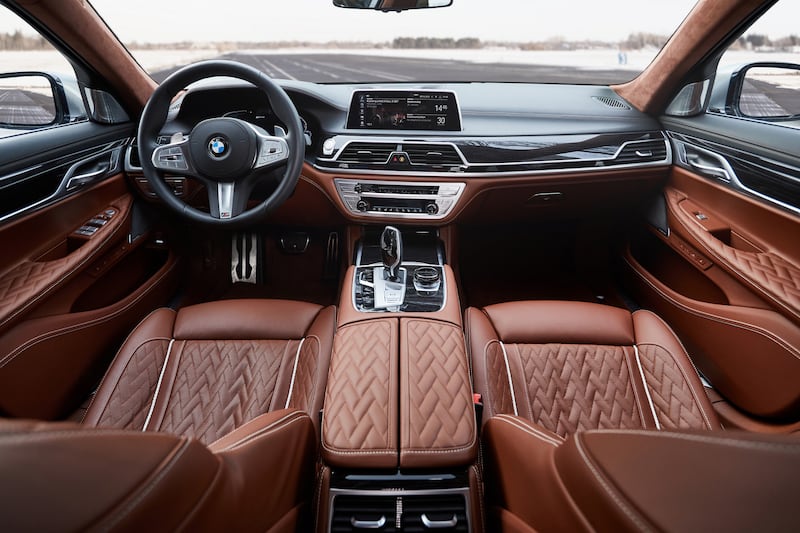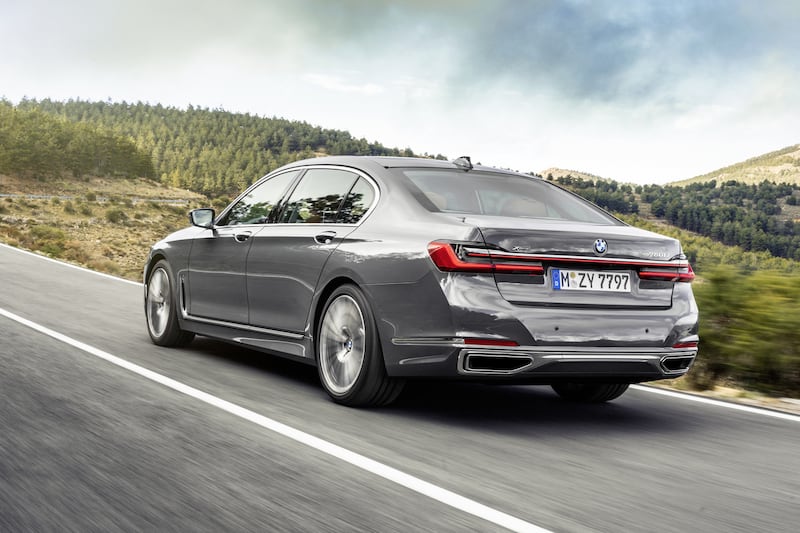BMW is determined that its flagship cars will stand out from the crowd.
Last month we were introduced to its behemoth X7 SUV and now weeks later comes the heavily-facelifted 7 Series. Both boast front grilles the size of a garden gate – and both suit this bold styling statement perfectly.
The trend towards SUVs – even amongst the luxury class who are driven rather than drive – means that there is a case to be made for saying the new X7 is now the standard bearer for this Bavarian brand.
Yet there remains a market for luxury saloons, currently dominated by the Mercedes-Benz S-Class.
What BMW brings to the table is a desire to entertain the driver as much as those being driven. That was the case when this generation of the 7 Series hit the market over three years ago. And that’s why, aside from the addition of a new plug-in hybrid version, the underpinnings of this 7 Series remain largely unchanged.

The end results is a car that measures in at over 5m yet can weave its way through the bends much like the smaller – and critically acclaimed – 5 Series.
That’s an incredible feat, but it was the visual similarities to the 5 Series that put some buyers off. When you’re handing over €100,000 you don’t want people confusing your shiny new luxury liner for a car half the price.
Bold conversion
What the designers have come up with is an unmistakably bolder and more luxury look for the car.
There’s that enormous front grille for a start. To incorporate it onto the car they had to raise the bonnet by 5cm and increase the size of the logo.
The end result is a snout that stands out in any company and a profile that bears a similar silhouette to the Rolls Royce Phantom (with which it shares a certain BMW bloodline).
Additionally, changes to the front and rear lighting – making them thinner and longer – adds a definite sense of width to the car. While it’s not quite as radical as Chris Bangle’s controversial 7 Series of 2002, it’s at least as bold.
There are significant changes in the cabin as well, with the window glass now 50mm thick and extra insulation all around to create an impressively quiet interior.
In terms of comfort, a herd of cattle were sacrificed for the sake of metres of quilted leather coverings and there is a sense of opulence about the cabin, though the outgoing model was no slouch in this regard.
The big news on the engine front is arguably the upgraded plug-in hybrid. Combining a 6-cylinder petrol engine with an electric motor and a 12kW battery pack, delivering 394bhp in total, an increase of 68bhp on the previous hybrid 7 Series.

Electric temptation
BMW claims 58km on EV charge alone, which is likely to equate to 40km in real world conditions, which is impressive for a car of this size that weighs in at over two tonne.
Drive it gingerly in hybrid mode and it delivers on its electric promise, though we’d really need to test it on a longer run.
However, given the current grant and tax incentives in place, the 745e plug-in hybrid model may well be the most tempting buy when the revised 7 Series range lands on forecourts next month, particularly those who spend the majority of their time cruising from urban office to suburban mansion.
The popularity of plug-ins is reflected across BMW’s range these days, with plug in hybrids on offer in its 2 Series, 5 Series, and X5 range, alongside fully electric models in the 3 Series. Next up will be a plug-in hybrid version of the X3, followed by a fully electric version of the car next year.
Back with the 7 Series and while the diesel range will still be the big seller here - with no engine changes in the 730d and 740d – BMW has upgraded the 4.4-litre 750 petrol version, adding another 82bhp which means this big luxury saloon hits 100km/h from a standing start in an impressive 4 seconds (4.1 seconds for the long-wheelbase version).
On the road, the 750 long wheelbase model delivers smooth acceleration, though there is a momentary delay when you kickdown the throttle before the V8 takes full affect. The addition of all-wheel drive on our test car gave added reassurance.
However, much as the driver will enjoy the power, for most 7 Series buyers – either travelling in the front or back – it’s all about the comfort.

Here the standard air suspension on both axles certainly adds to the limousine feel, although it was caught out by some of the more mountainous speed bumps we encountered on our test. And weaving through country bends did leave some passengers feeling a little queasy.
Prices start at €96,160 for the 730d, rising to €104,710 for the all-wheel drive “xdrive” version. The long wheelbase 730d starts at €101,910. But with hybrid in so much focus these days, several buyers may be more tempted by the plug-in 745e, starting at €100,510, and that’s before the €7,500 in VRT relief and SEAI grant.
BMW is well-established as the silver medallist in this class, behind the Mercedes-Benz S-Class, and the updates to the 7 Series means it maintains its substantial lead over its Audi, Lexus and Jaguar rivals.
The biggest boon is that the net results of the revision deliver a car that will not be mistaken for the 5 Series and has far more luxury touches.
Certainly in terms of styling, the new 7 Series makes the sort of statement you would expect from a €100,000-plus car.



















